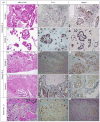Clarifying the spectrum of driver oncogene mutations in biomarker-verified squamous carcinoma of lung: lack of EGFR/KRAS and presence of PIK3CA/AKT1 mutations
- PMID: 22228640
- PMCID: PMC3487403
- DOI: 10.1158/1078-0432.CCR-11-2109
Clarifying the spectrum of driver oncogene mutations in biomarker-verified squamous carcinoma of lung: lack of EGFR/KRAS and presence of PIK3CA/AKT1 mutations
Abstract
Purpose: There is persistent controversy as to whether EGFR and KRAS mutations occur in pulmonary squamous cell carcinoma (SQCC). We hypothesized that the reported variability may reflect difficulties in the pathologic distinction of true SQCC from adenosquamous carcinoma (AD-SQC) and poorly differentiated adenocarcinoma due to incomplete sampling or morphologic overlap. The recent development of a robust immunohistochemical approach for distinguishing squamous versus glandular differentiation provides an opportunity to reassess EGFR/KRAS and other targetable kinase mutation frequencies in a pathologically homogeneous series of SQCC.
Experimental design: Ninety-five resected SQCCs, verified by immunohistochemistry as ΔNp63(+)/TTF-1(-), were tested for activating mutations in EGFR, KRAS, BRAF, PIK3CA, NRAS, AKT1, ERBB2/HER2, and MAP2K1/MEK1. In addition, all tissue samples from rare patients with the diagnosis of EGFR/KRAS-mutant "SQCC" encountered during 5 years of routine clinical genotyping were reassessed pathologically.
Results: The screen of 95 biomarker-verified SQCCs revealed no EGFR/KRAS [0%; 95% confidence interval (CI), 0%-3.8%], four PIK3CA (4%; 95% CI, 1%-10%), and one AKT1 (1%; 95% CI, 0%-5.7%) mutations. Detailed morphologic and immunohistochemical reevaluation of EGFR/KRAS-mutant "SQCC" identified during clinical genotyping (n = 16) resulted in reclassification of 10 (63%) cases as AD-SQC and five (31%) cases as poorly differentiated adenocarcinoma morphologically mimicking SQCC (i.e., adenocarcinoma with "squamoid" morphology). One (6%) case had no follow-up.
Conclusions: Our findings suggest that EGFR/KRAS mutations do not occur in pure pulmonary SQCC, and occasional detection of these mutations in samples diagnosed as "SQCC" is due to challenges with the diagnosis of AD-SQC and adenocarcinoma, which can be largely resolved by comprehensive pathologic assessment incorporating immunohistochemical biomarkers.
©2012 AACR.
Conflict of interest statement
Figures

References
-
- Selvaggi G, Scagliotti GV. Histologic subtype in NSCLC: does it matter? Oncology (Williston Park) 2009;23:1133–40. - PubMed
-
- Ladanyi M, Pao W. Lung adenocarcinoma: guiding EGFR-targeted therapy and beyond. Mod Pathol. 2008;21 (Suppl 2):S16–22. - PubMed
-
- Rodenhuis S, Slebos RJ. Clinical significance of ras oncogene activation in human lung cancer. Cancer Res. 1992;52:2665s–9s. - PubMed
-
- Marchetti A, Martella C, Felicioni L, Barassi F, Salvatore S, Chella A, et al. EGFR mutations in non-small-cell lung cancer: analysis of a large series of cases and development of a rapid and sensitive method for diagnostic screening with potential implications on pharmacologic treatment. J Clin Oncol. 2005;23:857–65. - PubMed
-
- Lee SY, Kim MJ, Jin G, Yoo SS, Park JY, Choi JE, et al. Somatic mutations in epidermal growth factor receptor signaling pathway genes in non-small cell lung cancers. J Thorac Oncol. 2010;5:1734–40. - PubMed
Publication types
MeSH terms
Substances
Grants and funding
LinkOut - more resources
Full Text Sources
Other Literature Sources
Medical
Research Materials
Miscellaneous

